Author: 0xWeilan
In the June report, we pointed out that due to sufficient wash trading and a significant amount of chips entering institutional hands, the next surge could be completed rapidly in the short term. We originally expected this breakthrough to occur in August or September, but if interest rate cut expectations drive forward-looking buying and structural allocation accelerates, it is possible that the surge could be brought forward to July.
The market rose as expected, and we saw this expectation quickly materialize in July. BTC rose 8.01% for the entire month and tested a historical high of $120,000.
Behind this is the material support formed by enthusiastic corporate purchases, continuous inflows from ETFs and stablecoin channels. However, the expectations for interest rate cuts and the actual situation of the tariff war have changed significantly, suppressing the rapid price surge and temporarily interrupting the unfolding of Altseason. There are still many uncertainties regarding whether interest rates can be cut in September.
Since 2023, American individual investors and businesses have gradually increased their allocation to crypto assets represented by BTC. By November 2024, after Trump is elected as the 47th President of the United States, BTC will be established as a national strategic reserve, and a series of crypto-friendly policies will be implemented, marking a complete farewell to the wild years for crypto assets and the blockchain industry.
However, deep participants in the crypto market are facing a situation of stark contrast. On one hand, BTC is being accumulated long-term by new funds, and its price is gradually reaching new heights; on the other hand, Altseason seems to never return, with Ethereum, regarded as the cornerstone of the blockchain industry, being driven down to $1,300 in April, below the price at the beginning of this bull market, leading market participants to lament the "collapse of faith." However, ETH quickly rebounded by 48.80% in July.
EMC Labs believes that the crypto industry is at a historical turning point, with structural changes so complex and trends so hidden that market participants have never seen before, thus presenting significant challenges. The factors determining asset prices have undergone tremendous changes, transitioning from a previous cycle of diminishing supply and demand and speculative frenzy to a new asset allocation logic within the chessboard of all types of assets.
We are in the torrent of industrial change.
Macroeconomic Finance: Inflation Rebound Vs. Disappointing Non-Farm Employment
In July, the U.S. capital market was mainly controlled by the interplay of three variables: "when the Federal Reserve will restart interest rate cuts + how the tariff war will end + the performance of economic and inflation data," with slightly enthusiastic forward-looking trading dominating the market, showing a tendency to actively go long most of the time, followed by a correction after the end-of-month news exceeded expectations.
The month was filled with drama regarding the Federal Reserve's restart of interest rate cuts. On one hand, Trump continued to exert extreme pressure on social media, even directly visiting the Federal Reserve to intimidate Chairman Powell with maintenance project overruns; on the other hand, the Federal Reserve adhered to its dual mission of "inflation + employment," insisting on a data-driven approach and making "hawkish" statements after the FOMC meeting. A split emerged within the Federal Reserve, with governors Waller and Bowman clearly supporting a quick interest rate cut, while governor Cook unexpectedly resigned.
After the FOMC meeting on July 31, the FedWatch pricing for a September rate cut briefly fell to a low of 41%, but after the unexpectedly strong non-farm data was released on August 1, this probability quickly climbed to over 80%.
For most of the time, the S&P 500 was driven by expectations of a September rate cut and strong corporate earnings. After July 28, as the probability of a September rate cut decreased, the market began to adjust after three consecutive months of significant gains. BTC also fell below $115,000, while Altcoins represented by ETH saw even larger declines.
In his speech after the FOMC meeting, the Federal Reserve Chairman emphasized that tariffs could further impact inflation data in the next two months.
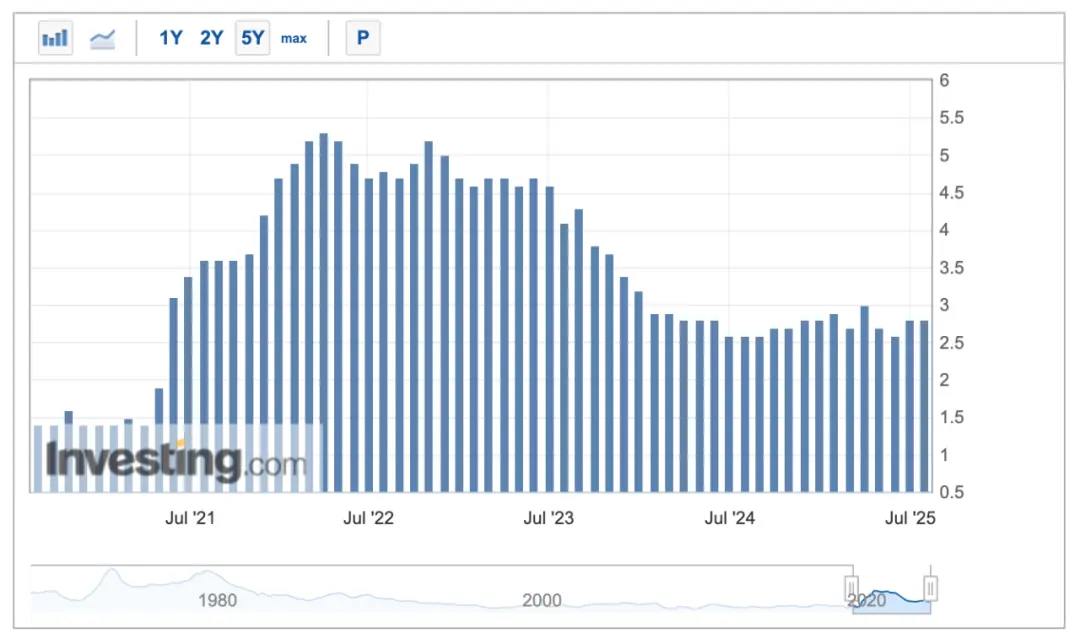
U.S. PCE Data
In July, Trump's announcement of higher tariff rates for more countries indeed exceeded market expectations. After two months of silence, the ongoing tariff war once again became a major factor influencing market pricing.
The current "reciprocal tariff" system has a four-layer structure: "10% baseline + 15-41% country gradient + EU special formula + 40% transshipment penalty." The highest 41% is mainly aimed at regions with high geopolitical security risks; the mid-range of 25-35% targets partners with large surpluses, high barriers, and limited negotiation progress; the 10% baseline is widely applicable and serves as a temporary plan for China.
Among the major trading countries/regions, the EU has 15%, Canada 35%, Japan 15%, South Korea 15%, Mexico 10% (general goods)/25% (automobiles, etc.)/50% (steel, aluminum, copper) (still under negotiation), and China 30% (temporarily suspended for 90 days pending determination). This outcome exceeded market expectations and heightened concerns about rising inflation, leading the market to reprice downward around August 1.
In terms of economic and employment data, the U.S. economy overall shows a "relatively resilient + relatively strong growth" trend. The U.S. Q2 GDP annual rate released on July 30 was 3%, reversing the negative growth trend of Q1 and exceeding expectations. In the financial reports released by large tech companies in July, it can also be seen that the AI wave is driving large enterprises to increase corporate investment, and AI investments have begun to drive profit growth.
Of course, there are hidden concerns behind the data, as consumer recovery remains weak, and overall corporate investment is still sluggish.
The non-farm data released on August 1 dealt a heavy blow to the market, causing a significant drop in U.S. stocks. The data showed that only 73,000 new non-farm jobs were added in July, far below the expected 110,000. Additionally, the May non-farm data was revised down from 144,000 to 125,000, and June was revised down from 147,000 to 134,000, with a total downward revision of 258,000 over the two months. These data significantly exceeded market expectations, causing panic over a "soft landing" and leading to a downward repricing.
Throughout the month, the market surged under expectations of interest rate cuts and economic non-landing, but the end-of-month release of tariff rates and non-farm employment data "heavily impacted" the market downward.
For the entire month, the Nasdaq, S&P 500, and Dow Jones indices rose by 3.7%, 2.17%, and 0.08%, respectively. BTC rose by 8.01%, and ETH rose by 48.8%.
In August, there remains a risk of downward repricing in U.S. stocks. After the disappointing non-farm data, the probability of a September rate cut returned to 80%, but concerns about inflation rebounding still haunt interest rate cut expectations. Additionally, while the employment data did not fundamentally impact the U.S. economy's growth for the year, it still poses challenges.
Whether interest rates can be cut as scheduled in September will be closely watched, with upcoming inflation and non-farm employment data being of great interest.
Crypto Assets: BTC Rising Continuation, Altseason May Open
In July, BTC opened at $107,173.21, closed at $115,761.13, hit a low of $105,119.70, and reached a historical high of $123,231.07 during the month, with a monthly increase of 8.01% and a volatility of 16.9%, with trading volume significantly larger than in June.
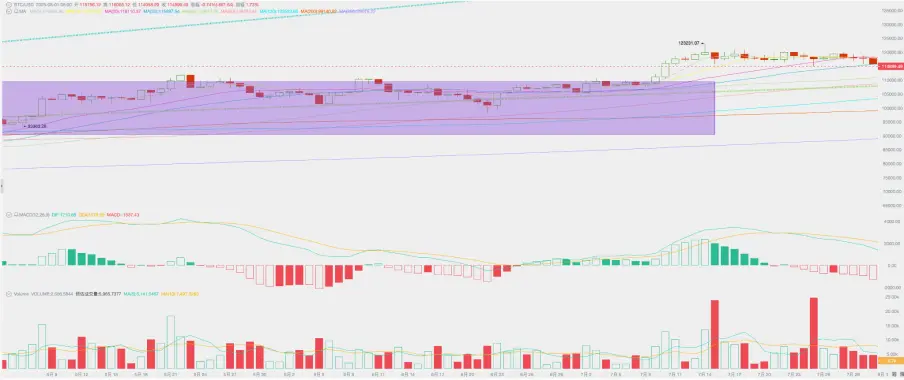
BTC Price Daily Chart
In the June report, we pointed out that BTC had been oscillating at the "Trump bottom" (purple area in the above chart) for 8 months, with sufficient turnover, and that Q3 had the conditions to initiate the fourth wave of the market. The market broke through this area in July as expected and continued to surge for several trading days. However, starting in mid-July, with long positions, especially ancient whales, selling off, combined with the turbulent macro-financial environment, BTC's price failed to maintain its upward momentum and instead entered another phase of consolidation.
From a technical indicator perspective, BTC is still operating above the 60-day moving average and the first bullish rising trend line (green dotted line in the above chart), with monthly trading volume increasing, indicating it is in a new upward continuation phase.
From a monthly cycle perspective, the MACD fast and slow lines are still in the expansion phase, showing that the market is still in a strong upward momentum.
In terms of contracts, the open interest has continued to rise from the beginning to the end of the month, indicating strong market bullish sentiment. However, starting in the latter half of the month, both open interest and funding rates showed a significant decline, as a certain scale of leveraged funds chose to exit for risk aversion amid increasing uncertainty.
Another important event in July was the apparent re-initiation of Altseason within the crypto market. Driven by strong corporate purchases, ETH rose 48.8% in a single month, and the ETH/BTC trading pair broke through technical resistance. We believe that with the proximity of interest rate cuts and an increase in risk appetite, the reopening of Altseason is highly probable.
Chip Structure: Long-term Hands Initiate Third Round of Selling
With the buying power arriving in July, long-term holders initiated the third wave of selling in this bull market.
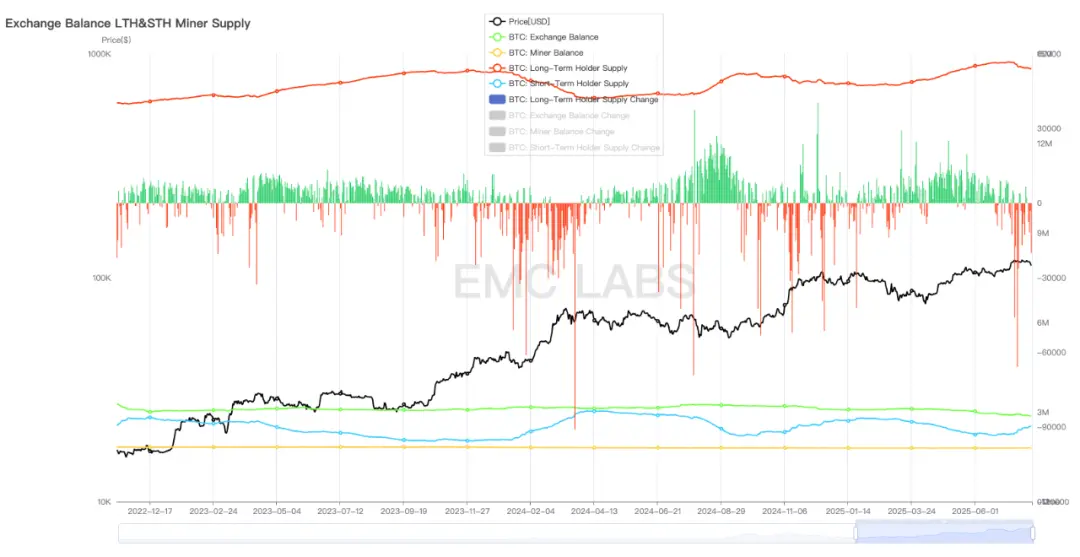
Long and Short Positions and Changes
According to eMerge Engine data, long-term holders reduced their holdings by nearly 200,000 BTC in July, including 80,000 BTC from a wallet that originated in the Satoshi era. Correspondingly, short positions also rose rapidly.
BTC flowed from long-term holders to short-term holders, increasing the market's short-term liquidity and putting pressure on prices. However, it can be seen that the short-term selling by ancient whales had a much smaller impact on market prices compared to the past, indicating that as the market participant structure changes, market depth has significantly increased.
Centralized exchanges continued to see BTC flowing out (over 40,000 BTC), indicating that institutional purchases are still ongoing. Institutional allocation is the direct driving force behind the upward price of BTC in this bull market.
By the end of July, publicly listed companies directly holding BTC had exceeded 4.5% of the total supply.
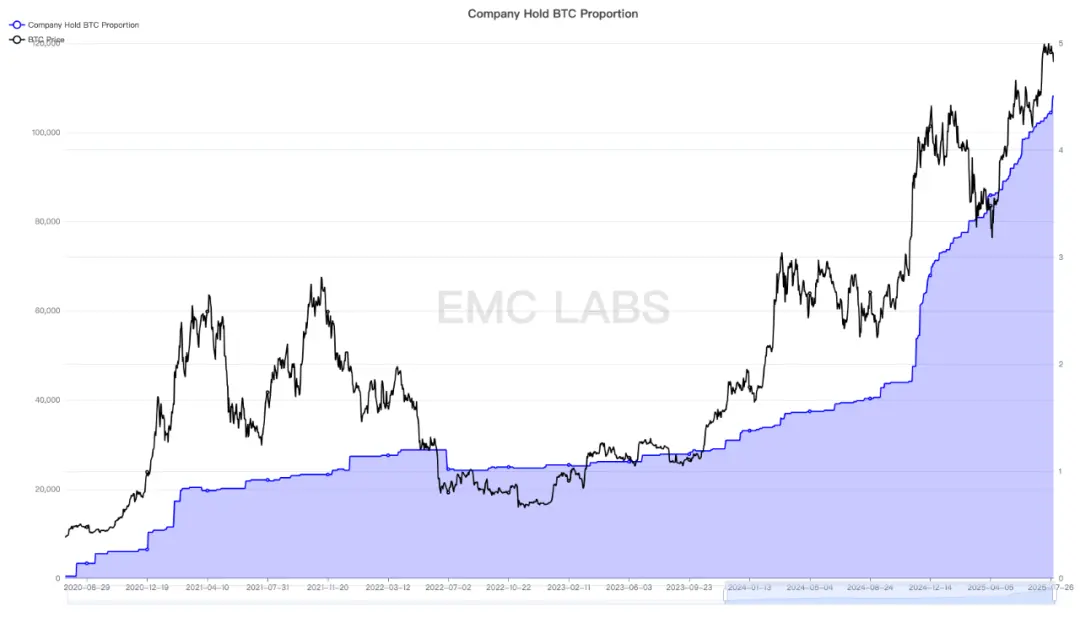
Statistics on Company Holdings of BTC
Since the beginning of this year, the scale of direct BTC purchases by publicly listed companies and other institutions has surpassed that of the BTC Spot ETF channel, officially becoming the largest buyer in the BTC market.
Capital Flow: Over $29.5 Billion Inflow, Second Largest Month in History
This month saw a total inflow of over $29.5 billion into the crypto market, including $12 billion in stablecoins, $11.3 billion in BTC + ETH Spot ETFs, and $6.2 billion in corporate purchases. Corporate purchases are the single largest source of buying power in the BTC market that can be tracked.
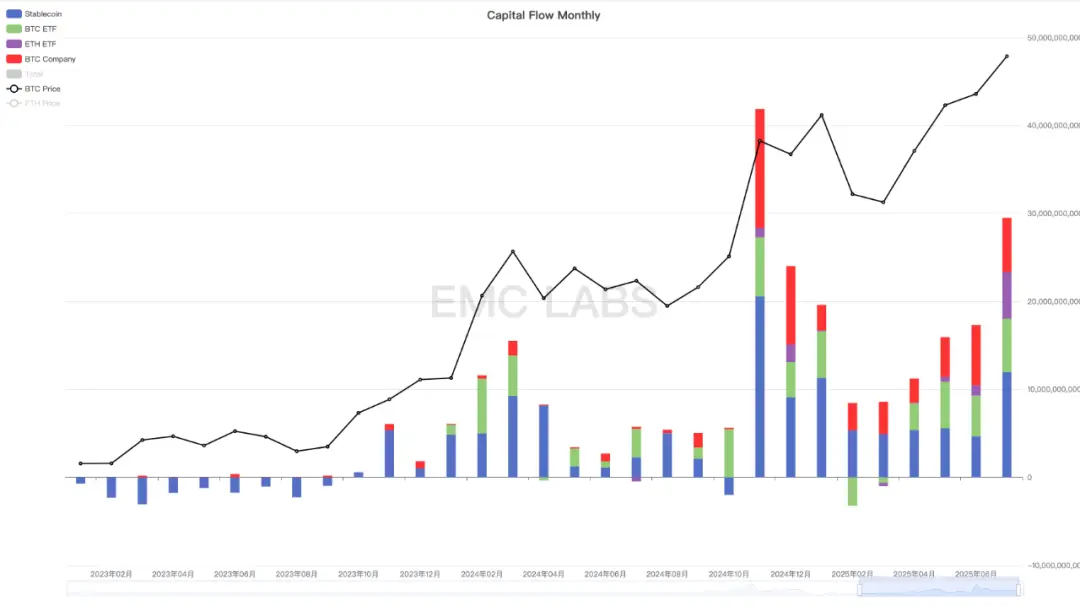
Monthly Statistics on Crypto Market Capital Flows
The total inflow of $29.5 billion made July the second largest inflow month in history, allowing BTC to break through the 8-month consolidation area, absorbing massive selling pressure and pushing prices to new historical highs.
It is worth noting that total capital inflows have increased for five consecutive months, driving BTC to continue rising from the half-year low set in April and reaching new historical highs.
American companies' allocation to BTC continues to accelerate, with more and more companies joining in, and it is expected that this will remain the most important factor driving price increases in the near future.
Additionally, this month, ETH Spot ETF inflows reached $5.298 billion, marking the highest month in history, approaching the $6.061 billion of the BTC Spot ETF channel. This is accompanied by the proximity of interest rate cuts and further expansion of crypto assets in the U.S., with more and more capital beginning to flow into ETH. At the same time, the number of companies allocating ETH is also increasing, and by the end of the month, these companies' ETH allocations accounted for 2.6% of the total circulation, although still lower than BTC's 4.6%, but growing rapidly, with ETH's pricing power shifting from on-market to off-market.
Conclusion
eMerge Engine shows that the BTC Metric is 0.75, indicating that BTC is in a bull market rising phase.
From a multi-dimensional analysis perspective, BTC is still in the continuation phase of the fourth wave of this bull market, and after a period of fluctuation in August, it is highly likely to continue upward.
Led by ETH, as interest rate cuts approach, the overall market's risk appetite is likely to increase, and Altseason is expected to open.
The tariff war conflict, U.S. inflation, and employment data pose the greatest tail risks.
免责声明:本文章仅代表作者个人观点,不代表本平台的立场和观点。本文章仅供信息分享,不构成对任何人的任何投资建议。用户与作者之间的任何争议,与本平台无关。如网页中刊载的文章或图片涉及侵权,请提供相关的权利证明和身份证明发送邮件到support@aicoin.com,本平台相关工作人员将会进行核查。




